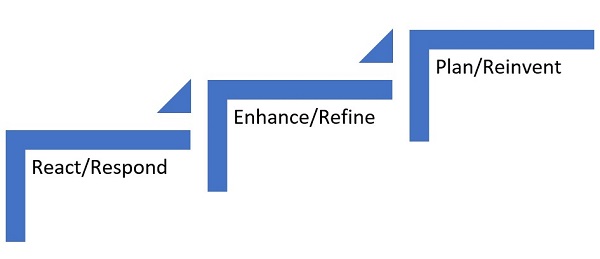Eric Krapf, GM and program co-chair for Enterprise Connect, posed an interesting question about my upcoming
virtual event session on UCC end-user adoption and training. He wondered if user adoption was still significant during the COVID-19 crisis since people have been sent to work from home (WFH) with communications tools provided by their organizations. Because if you’re told which tools and technologies to use while working remotely, does user adoption matter? That got me thinking.
Organizations that needed to get UCC apps to their WFH employees in the early days of the shelter-in-place orders didn’t have time for a proper UCC user adoption program or strategy. And if there’s no choice in the matter, then adoption really isn’t an issue — or is it?
As I thought about it, I realized that yes, user adoption and training is even more important and necessary now than in the days before COVID-19, especially as we move beyond the pandemic’s initial stages. While the COVID-19 crisis accelerated the move to videoconferencing, UCC user adoption isn’t a foregone conclusion. Case in point — just because IT widely deploys a great team collaboration application doesn’t mean that Joe in accounting will stop sending emails with attachments to share files with Barbara in accounts payable. Without the proper knowledge, understanding, and training on the tools provided, employees are still likely to use the tools with which they’re most familiar.
The pandemic has accelerated organizations’ digital transformation strategies, including the move to cloud services. Companies that were planning on moving to a cloud-based UCC service in the next six to 18 months realized they needed to deploy the new services ASAP. Without aggressive adoption programs, digital transformation strategies will go out the window as people fall back to their older, safer methods. In addition, without an adoption program for the new and transformative tools, users may bring their own solutions. For example, people who have been using Zoom for virtual family gatherings, religious services, and happy hours, could be using it for work, without the blessing of their IT department. Without IT in the picture, security and compliance issues may arise.
COVID-19 Responses in Stages
Pandemic response breaks into three stages:
- React/respond
- Enhance/refine
- Reinvent/plan
Where any organization is in its response depends on geographic region, which impacts the role of user adoption and training. As cases continue to rise in the U.S., Brazil, India, and other countries but decline in China and much of Europe, the timing of when organizations in these regions evolve to the next phase will vary.
Stage 1: React and Respond
The initial shock of COVID-19 led organizations to make business continuity their top priority. This meant quickly enabling WFH and granting workers access to the corporate network and phone system from laptops, home computers, or mobile devices. Organizations that had UCaaS and cloud-based collaboration applications were one step ahead.
To help organizations transition to WFH and cloud services, many UCC vendors provided temporary free or discounted offers (
click here for a full list.) During this stage, many organizations took advantage of these offerings to help employees more easily transition to WFH environments. This required user adoption and training.
While many organizations already had UCC solutions deployed, usage and adoption were spotty and inconsistent in many cases. With the urgent need to use these tools to communicate and collaborate effectively with colleagues, partners, customers, and suppliers — most of whom were also working remotely — adoption and usage of the UCC tools was a necessity. Users need to know when, how, and why to use the basic and more advanced functions. Knowing how to mute oneself and others on a video call or how to use a virtual background has become indispensable (especially with kids or dogs around).
IT must train workers on how to launch scheduled and ad-hoc meetings from any device or from within a third-party application like Salesforce. In many cases, users aren’t aware of the more advanced features within their UCC tools, and this undoubtedly limits their usage.
Stage 2: Enhance and Refine
Most organizations are currently in this second stage, working to identify what has been working and what isn’t working, while defining best practices for the future. At this point, user adoption focuses on overcoming resistance to the new tools by some workers and increasing utilization of more advanced UCC features and capabilities. For organizations that have deployed new UCC capabilities, the emphasis is on best practices. These include how to support spontaneous brainstorming in a WFH environment, and how to engage employees when some are working from home and others in the office.
Video has been the WFH technology du jour, a good alternative to in-person meetings and interactions. Now that the technology’s novelty has worn off and everyone — regardless of age or demographic — is accustomed to using video, how do businesses maintain usage and fight off video fatigue? Organizations will need to develop strategies to address these issues.
Stage 3: Plan and Reinvent
The final stage revolves around planning for the future — the “next normal” — by identifying new needs and developing new strategies. Organizations that took advantage of the freemium or discounted cloud offerings for WFH will have to decide whether to deploy these services as a long-term solution. Reports from various vendors and channel partners indicate that around 10% to 20% of the free or trial users have converted to paid licenses, with businesses expanding and deploying these services to different locations or offices.
Many businesses that haven’t bitten the cloud services bullet are now looking into UCaaS, especially as it offers the business continuity and scalability that is desperately needed. As organizations look to purchase and deploy new cloud-based UCC services, they need to go through the typical user adoption strategy steps.
Changes Afoot
Don’t misunderstand me — user adoption and training are still necessary, but strategies will need adjusting. It’s a given that online training will replace hands-on, in-person classroom training and that internal marketing will involve more emails rather than posters hung up in the office. To explore what else will change, join me and my BCStrategies colleague Kevin Kieller on Thursday, Aug. 6, from 2:00 p.m. to 2:45 p.m. ET, for our “
Best Practices for UC&C Training and Adoption in a World of Distributed Work” session at
Enterprise Connect Digital Conference & Expo 2020, taking place online Aug. 3 to 6. We’ll discuss what you need to know about UCC adoption and training considerations for a post-COVID-19 world, the role of analytics, how to determine what is and isn’t working, and more.
Registration is now open; I hope you can join us!
This post is written on behalf of BCStrategies, an industry resource for enterprises, vendors, system integrators, and anyone interested in the growing business communications arena. A supplier of objective information on business communications, BCStrategies is supported by an alliance of leading communication industry advisors, analysts, and consultants who have worked in the various segments of the dynamic business communications market.












